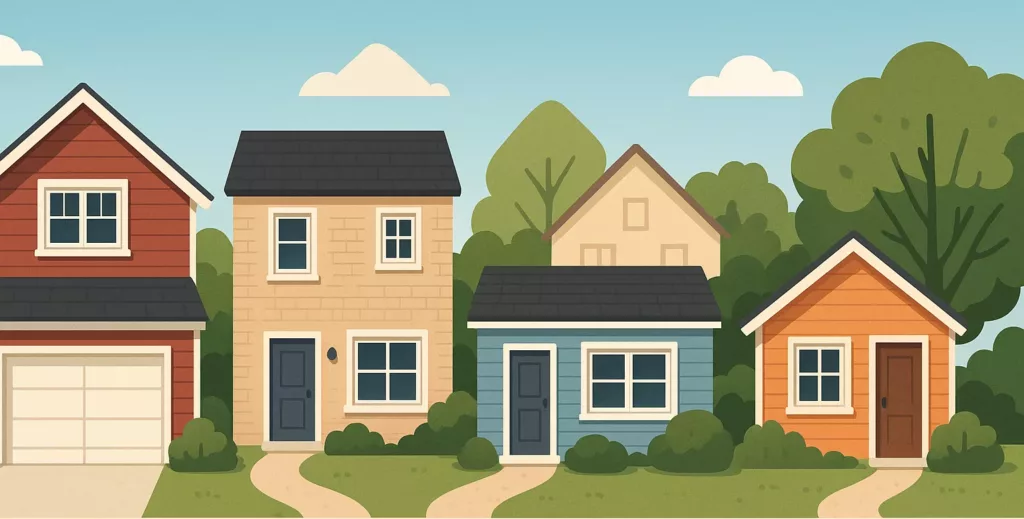
Estimated reading time: 8 minutes
Types of ADUs: A Detailed Guide for Canadian Homeowners
Key Takeaways
- Versatility: ADUs come in various forms including coach houses, laneway suites, secondary suites, and backyard cottages to suit different needs.
- Value Boost: Adding an ADU can increase your property’s resale potential and generate additional income.
- Flexible Living: ADUs support multigenerational living, guest accommodations, and rental opportunities.
- Regulatory Considerations: Zoning requirements, lot sizes, and permitting vary significantly across Canadian municipalities.
- Informed Investment: Understanding each ADU type helps homeowners make better decisions about maximizing land use and property value.
Table of Contents
Accessory Dwelling Units (ADUs) are self-contained residential units located on the same lot as a primary dwelling. They may be attached, integrated, or completely separate from the main home. Canadian homeowners are increasingly exploring ADUs to address urban density, affordable housing challenges, and the need for more flexible living options.
This detailed guide walks you through the different types of ADUs – from coach houses and laneway suites to secondary suites and backyard cottages – and explains their benefits and regulatory requirements. For further insights into ADU concepts, see Accessory Dwelling Units Guide.
Sources: XpertSource, Centris
Coach Houses: Detached ADU with Maximum Privacy
Coach houses are detached ADUs typically located at the rear of a property. They provide complete independence with their own entrances and often embody repurposed structures such as former garages or carriage houses.
Distinct Features of Coach Houses:
- Private and independent from the main dwelling
- Enhanced privacy and separation ideal for rental or family use
- Often derived from repurposed structures or newly built
For related insights on flexible living options, check out the Granny Flats Essential Guide.
Source: Team Shane
Laneway Suites: Urban Flexibility in Underused Spaces
Laneway suites are detached ADUs constructed adjacent to public laneways. They effectively utilize underused urban spaces, enabling homeowners to add modern living spaces in densely built environments.
Key Attributes of Laneway Suites:
- Located along public laneways to maximize space usage
- Purpose-built for modern urban lifestyles
- Facilitate urban infill while preserving neighborhood character
Discover more about urban housing solutions at Urban Infill & Tiny Homes ADU.
Source: Team Shane
Secondary Suites: Affordable, Integrated Living
Secondary suites are ADUs created within the primary residence, such as basement apartments, in-law suites, or attic conversions. They leverage existing infrastructure, making them a cost-effective solution for additional living space.
Highlights of Secondary Suites:
- Integrated within the main home for efficient use of space
- Generally more affordable and quicker to construct
- Ideal for multigenerational living or rental purposes
For details on the benefits of secondary units, visit Secondary Unit Benefits in Canada.
Sources: Centris, Team Shane
Backyard Cottages: Flexible, Standalone Additions
Backyard cottages, also known as garden suites, are detached units located in the rear yard. They can be newly built or converted from existing structures like sheds, offering high flexibility in design and use.
Attributes of Backyard Cottages:
- Fully detached and customizable
- Can serve as guest houses, home offices, or rental units
- Best suited for properties with larger lots
For an in-depth look, refer to the Backyard Cottage Canadian Guide.
Sources: Team Shane, Accessory Dwelling Units Best Practices
Comparison and Suitability: Matching ADU Types to Canadian Needs
Choosing an ADU depends on your property, budget, and goals. Each type offers distinct advantages along with unique zoning, lot size, and construction cost considerations.
| ADU Type | Main Benefit | Best For | Key Considerations |
|---|---|---|---|
| Coach Houses | Privacy, Rental Potential | Extended Family or Renters | Zoning, Minimum Lot Size, Build Costs |
| Laneway Suites | Urban Infill, Diversity | City Lots with Laneways | Lane Access, Incentives |
| Secondary Suites | Cost-effective, Quick Build | Existing Homes | Building Codes, Utility Access |
| Backyard Cottages | Versatility, Design Options | Large Lots, Multi-use | Lot Space, Permitting Process |
Important Considerations:
- Check local zoning and permitting requirements; refer to the Canadian ADU Regulations Guide.
- Detached units generally incur higher construction costs compared to integrated secondary suites.
- Assess your property’s lot size and utility provisions when selecting an ADU type.
Conclusion: Understanding Types of ADUs Empowers Canadian Homeowners
Gaining insight into the various ADU types – coach houses, laneway suites, secondary suites, and backyard cottages – empowers homeowners to make informed decisions that enhance property value and cater to flexible living demands. Whether you are targeting rental income, multigenerational housing, or expanded living space, ADUs offer practical solutions.
Always consult local building codes and planning experts before making any investments. For financing tips and additional guidance, visit the ADU Financing Canada Guide.
Sources: Vigo House, XpertSource, Centris
Additional Resources: Canadian ADU Guidelines and Further Reading
Explore these resources for further guidance on planning, design, and local regulations:
- Municipal Guidelines:
- Guidebooks and Case Studies:
- Explore More: Consult local builders and browse listings featuring ADUs for real-world examples and inspiration.
Frequently Asked Questions
Q1: What is an ADU?
A: An ADU (Accessory Dwelling Unit) is a self-contained living unit located on the same lot as a primary residence, often used for rental, guest accommodations, or extended family living.
Q2: What are the different types of ADUs available in Canada?
A: The main types include coach houses, laneway suites, secondary suites, and backyard cottages – each offering unique advantages based on the property’s size, zoning laws, and intended use.
Q3: How do I determine the best ADU type for my property?
A: Consider factors such as your lot size, budget, and local regulations. Evaluating your needs – whether for rental income, additional family space, or flexible home office use – and consulting local experts will help guide your decision.

Leave a Reply